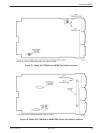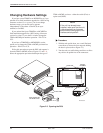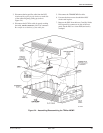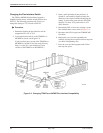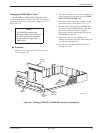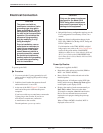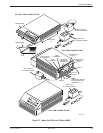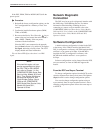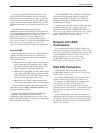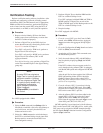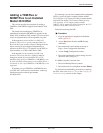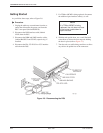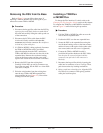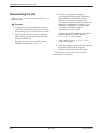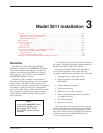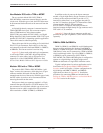
Model 3610 Installation
2-113610-A2-GB41-60 March 1999
To change configuration options of the Model 3610
DSU from the DCP or the Model 3610 from an async
terminal, select the Local branch, then the Configuration
(Confg) branch. (If not displayed, press the
key until
Confg is displayed, then press the function key below the
selection.) Select Opts (for Configuration Options), then
Load.
For additional information about changing
configuration options from the DCP or async terminal or
for a listing of messages received during installation, refer
to the COMSPHERE 3600 Series Data Service Units,
Models 3610 and 3611, Time Division Multiplexer,
Multichannel Multipoint, and Digital Bridge Options,
User’s Guide, Chapter 3, or order the COMSPHERE 3600
Series Data Service Units, Models 3610 and 3611,
Operator’s Guide and refer to Chapter 6 and Appendix E.
From the NMS
Software configuration options for a Model 3610 with
a TDM or MCMP can also be set from a 6800 Series
NMS using the Change commands. These commands
include the following:
• cho followed by the DSU’s network address allows
you to change the DSU, Diagnostic (DSU, DBM,
and General), General, MUX Setup and Port, Port
Speed, and LPDA configuration option sets.
• cho followed by the DBM’s network address allows
you to change the DBM, Backup, Diagnostic (DSU,
DBM, and General), General, MUX Setup and Port,
and Port Speed configuration option sets.
• cha followed by the DSU’s serial number allows
you to change the tributary DSU’s network address.
For the 6700 Series NMS, configuration options are
menu-driven. Select Config→Network→Devices→ the
appropriate submenu selection.
Tributary 3610 DSUs with TDM or MCMP can be
configured from an NMS provided the Position
configuration option (Diagnostic General) is set to Trib
from the DCP and the DSU is connected to a control DSU
that is connected to the NMS.
The COMSPHERE 6700 or 6800 Series NMS, which
uses the Advanced Diagnostic protocol (ADp), fully
supports configuration of the DSUs with TDM and
multipoint dial backup or MCMP. Refer to the NMS
documentation as needed.
Configuration of the DSUs from an NMS using either
the DPII or DMC protocol is subject to the same
limitations identified in the COMSPHERE 3600 Series
Data Service Units, Models 3610 and 3611, User’s Guide
or the COMSPHERE 3600 Series Data Service Units,
Models 3610 and 3611, Operator’s Guide.
Network and LADS
Connections
For connection to the DDS, switched 56 kbps, and
public switched telephone or dial networks, or to a local
area data set (also called a limited-distance modem), refer
to the COMSPHERE 3600 Series Data Service Units,
Models 3610 and 3611, User’s Guide, or the
COMSPHERE 3600 Series Data Service Units,
Models 3610 and 3611, Operator’s Guide.
DSU DTE Connection
Make the DTE connection as described in the
COMSPHERE 3600 Series Data Service Units, Models
3610 and 3611, User’s Guide.
In a TDM or MCMP application, only DSU Port 1 is
capable of interfacing to an EIA-232 connector or a
V.35 connector. In a DSD application, an option card
allows all ports to operate as either EIA-232 or
V.35 interfaces. In a Flex application where the DSU
firmware version is less than 6.3x, a Flex interface switch
allows all ports to operate as either EIA-232 or an V.35
interface.
Ports 2 through 6 have only EIA-232 connectors. If
speeds higher than 19.2 kbps are selected for these ports,
an Paradyne special cable provides an interface between
the TDM’s or MCMP’s D-type connector and the DTE
cable’s V.35 connector.



